losboz
Full Member
  
Member since: September 2013
Posts: 322 
|
Post by losboz on Mar 20, 2023 8:53:13 GMT -5
Having completed two 1/35 Trumpeter 8T (Sd.Kfz.7) kits (recently posted one here) over the last few years I figured I would finish a couple of the Dragon versions. Between a few other projects my plan this year was to complete two of the Dragon kits I had started some years ago. First up will by Dragon's kit #6562. This was the final all wooden cab and cargo bed version (Holzpritsche) and was released way back in 2009.  The details are sharp, the engineering good and the kit fits together very neatly. Unfortunately, it has very different issues from the Trumpeter offering. The largest issue is an inaccuracy concerning the cargo bed framework. Although not hugely visible on the finished model, Dragon have not designed new mouldings but have just included the reinforced framework from their Flak variant which is totally different from the cargo version. The Trumpeter kit's framework is correct. In addition, they have not updated the instrument panel to the 'late' full horizontal panel used on the newly designed wooden cab, nor have they included the late running gear (wheels and tracks). Late versions were occasionally seen with the early wheels (The hubs are visably different) and only very few received the final tracks so although not entirely incorrect it would have been nice for Dragon to have updated the tooling for these too! Although no canvas tilt is offered, they do provide the wooden equipment rack, but just like Trumpeter, they also misinterpret the layout of the rear bench, and include two side facing benches instead of the correctly orientated back-to-back layout. The kit's clear plastic windscreen moulding depicts the older style drivers’ side split screen with opening which was dropped on the Holzpritsche vehicles in favour of two solid screens. Other issues that are easily resolved include replacing the engine bay horn to represent the Bosch circular style one and moving the cab tilt hoop frame from the load bed to the cab. A full and excellent kit review can be found here: www.perthmilitarymodelling.com/reviews/vehicles/dragon/dr6562.html I started this build in around 2015 and the main components have already been assembled. The only aftermarket parts I used was a set of 'Quick wheel' front wheels. These come in two parts so they can be presented minus the rim and tyre as I will presented on this build. To construct them the star shaped spokes simply 'click and turn' into the rim and tyre section. I built the kit up in sub sections to make painting easier but unlike my Trumpeter kit build, on this occasion I had already attached the cab to the chassis. This means that some areas I would have liked to improve on will have to remain. These are some WIP build pics I took back in 2015.   A 'beat up' image of the real thing. Notice half the wheel rim hanging off the star shaped inner wheel hub and the other half sat on the ground below it. This vehicle has the curved upper cab side panel and the rear drop side cut out was to allow it to be lowered whilst towing. The cab canvas supporting hoop is sticking out of the cab floor.  The image below shows the rifle rack holders attached to the storage rack (arrowed) which was a very late re-vision which allowed a simple removal and convertion to a flatbed. The rack location pins (circled) can also be seen as the rack has fallen out of the cargo bed location slots.  The rear back-to-back style bench remains in the example below.  Both the images below show the smaller, late style headlamps not supplied in either of the Holzpritsche kits. The first image shows a short, bevelled cab side panel and the second a curved.   The pics below were taken before the Trumpeter kit was painted so we can compare them side by side. The most striking difference is the height of the tilt frame! The Trumpeter tilt looks far too low, and this seems to be confirmed in period images. The next thing to notice is how soft the Trumpeter kit’s details look in comparison. The Radiator housing fins being a prime example. The front fender profile difference is also clear to see here. The Dragon kit has the correct one. The Trumpeter model's running gear and front wheels also sit a little lower on the chassis.    Re-working some Dragon kit inaccuracies. Re-working some Dragon kit inaccuracies. Although it would now be tricky to re-work the load bed platform without damaging existing fittings, I did want to address the most visual inaccuracy. Dragon do not provide the late style instrument panel and as they do not provide a cab tilt cover this will be very noticeable. I had not been aware of this issue when I built the kit, so this was now to be remedied. Although the Trumpeter kit’s panel would still have required extending as the Dragon cab is a few millimetres wider, I didn’t have one spare so building one from scratch was the only alternative. Carefully removing the old panel and framework the first thing to remedy was the inclusion of the priming fuel tank to the firewall. Luckily this part can be found in the kit. It looked very different to the Trumpeter part but as only the lower portion would be visible it could be added. Using the Panzer Tracts 22-4 book for reference, the new panel was constructed from plastic card, photo-etch, and scraped off switches from the old panel. It wasn’t perfect but under paint and with dial decals it will be presentable. The old style central panel provided in the kit  Scratchbuilt full panel  As the kit has been built up with displaying the engine in mind, the trumpet style ‘early’ horn was replaced with the correct style circular Bosch item, taken from the Trumpeter kit. The bonnet/hood photo-etch tool clasps were replaced with 3D resin ones and again the headlights were replaced with a smaller ‘later’ style set. Although the radiator housing manufacturers logo would have been absent on a vehicle this late in the war, the fact that I have already attached it makes removing it difficult so that will also have to remain.The cab canvas metal hoop frame should be attached to the rear of the cab side panels. All the kit's illustrations bear this out but strangely the instructions have you attach it to the cargo wooden frame! I had also draped some green stuff tarps over it when I originally built it so unfortunately this error will also remain. Looking at drawings in the Panzer Tracts book, other kit inaccuracies that will also require work as the kit builds up include the cab under-seat metalwork. It should sit further back on the floor and not sit flush with the cab side panels and there is no driver’s seat cut out for the deeper cushion. Another more visible anomaly concerns the cargo bed hinges. They look to be far too chunky in scale and there is no detail on the inner face.    Next up will be paint |
|
|
|
Post by Tobi on Mar 20, 2023 9:28:32 GMT -5
These side by side comparisons are always extra nice!
I notice also the front axle spring is different in both kits, with the Dragon version looking much more like in the photos.
|
|
|
|
Post by mustang1989 on Mar 20, 2023 11:20:22 GMT -5
That is indeed a GREAT side by side comparison on this subject. It just makes me want to tip over the edge and get one now. Love the attention to detail that you're putting into this one buddy.
|
|
losboz
Full Member
  
Member since: September 2013
Posts: 322 
|
Post by losboz on Mar 20, 2023 11:22:25 GMT -5
These side by side comparisons are always extra nice! I notice also the front axle spring is different in both kits, with the Dragon version looking much more like in the photos. Almost everything on the Trumpeter kit is chunky by comparison! |
|
losboz
Full Member
  
Member since: September 2013
Posts: 322 
|
Post by losboz on Mar 20, 2023 11:24:13 GMT -5
That is indeed a GREAT side by side comparison on this subject. It just makes me want to tip over the edge and get one now. Love the attention to detail that you're putting into this one buddy. Cheers Joe. The Dragon versions are the ones to go for if you dont fancy many bouts of random cursing, head scratching and head shaking  |
|
|
|
Post by mustang1989 on Mar 20, 2023 11:42:30 GMT -5
These side by side comparisons are always extra nice! I notice also the front axle spring is different in both kits, with the Dragon version looking much more like in the photos. Almost everything on the Trumpeter kit is chunky by comparison! Try their aircraft sometime if you want to invent some new swear words. My dictionary is FULL of 'em. |
|
|
|
Post by `Boots` on Mar 20, 2023 16:28:51 GMT -5
Some great building Los and nice to see the comparisons as well  |
|
|
|
Post by chromdome35 on Mar 21, 2023 12:30:52 GMT -5
I love it, how are you getting your green stuff tarps so thin?
|
|
losboz
Full Member
  
Member since: September 2013
Posts: 322 
|
Post by losboz on Mar 23, 2023 5:36:22 GMT -5
Thanks bud. It's that long ago since I built it I dont remember exactly! What I use now is a small rolling pin and some talc to stop it sticking so I'm sure it would have been a similar process.
|
|
losboz
Full Member
  
Member since: September 2013
Posts: 322 
|
Post by losboz on Mar 23, 2023 9:21:02 GMT -5
Before I committed to priming the model, some more paraphernalia including tarps were added to the cargo and cab areas. The cab bench received some crew gear along with some rope and a canteen lid. The engine bay also received some rags and cloths to give the impression the engine had been worked on before it was abandoned.
Primer coat. The whole model received a primer coat of Mr Surfacer 1500 black. Any imperfections were dealt with and then it was time to decide on a base coat. Unlike the very odd coloured box art, all these late war vehicles would have left the factory in plain Dark yellow (Dunkelgelb). Any camouflage would then have been applied in the field.
 
Having already completed the Trumpeter kit in a monochrome finish I considered adding some camo but as I had such a small canvas to work with and looking at various reference images, including the photo I will base the build on, I decided this would also remain in its factory applied paint...with maybe a faded whitewash, depending on how I feel after the base colours go down.
Undercoating
With the primer colour acting as a shadow coat, starting off with the natural undercoat colours, all the metal components including the visible areas of the chassis, cargo bed frame, tilt poles, cab floor and bulkhead, bonnet, radiator housing, fenders and wheels received a light airbrushed coat of MRP red oxide primer colour. (Not their red oxide primer) A lightened coat of Tamiya grey/buff acrylic was airbrushed over any visible wooden areas including the cab side panels and horizontal tilt beams.Two coats of fine mist hairspray were then sprayed over the whole model.
 
Base coat
Using my ready mixes of both MRP lacquers and Tamiya acrylics thinned with Mr Hobby Levelling Fluid and keeping the layers light to aid the hairspray chipping, slightly modulated mixes of Dark Yellow (Dunkelgelb) made up the base coat. The darkest mix was applied to the running gear and lower areas. The second coat feathered into and above the first mix and was then followed by a further lightened coat to all the upper areas. A final highlight mix was lightly misted from overhead.
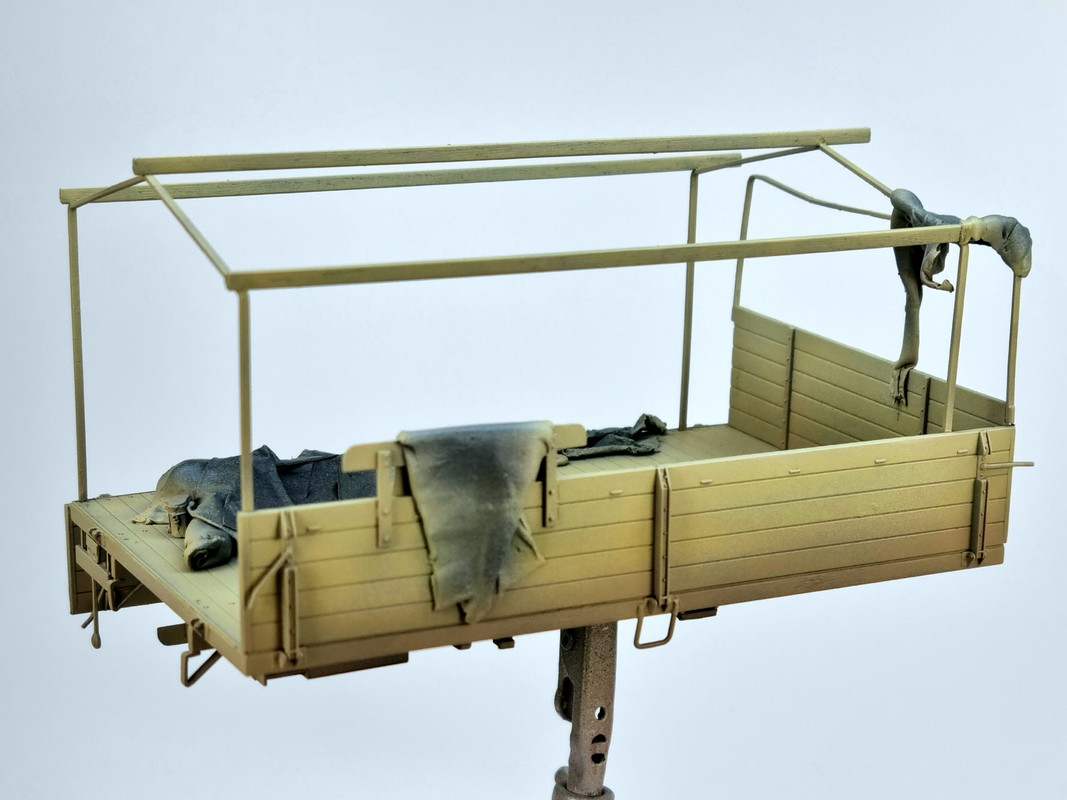 
Hairspray chipping
I have always found the best results can be obtained using acrylic paints but with a slightly different approach it can also be effective using lacquers. Keeping the paint layers thin with just the right amount of hairspray coverage is the key. To achieve a realistic effect over multiple colours means adding hairspray in-between each layer. Although it is possible to ‘chip’ through multiple layers with acrylics, it is much harder to achieve with lacquer paint, and I have found chipping each layer as you go makes life a little easier. It is then far easier to adjust the level of chipping and fine-tune the effects along the way.
Base coat paint mixes added.
Base coat chipped.
To improve the effect further, a third layer of paint (Dark grey) was added where the pioneer tools were located and again chipped back. The tailgate received the same treatment and a few highlights have started to be added with brush painted acrylics.
A slightly different approach was taken with the wooden panels of the cargo bed. To replicate the damage by loading and unloading items the floor and side panels would also have attracted scuffs as well as scrapes. The three horizontal top tilt frame beams were wooden too, but the bed frame and tilt poles were all made of steel. As these areas were primed with their corresponding undercoat colours; red primer on the steel and a grey/buff shade for bare wood, selected areas were now picked out and distressed.
The base coat layer chipped and scuffed exposing both the bare wood colour and the metalworks red oxide primer coat.
To tone down any exposed red primer on the frame and tilt poles, a light layer of Tamiya German Grey acrylic was airbrushed over another hairspray layer. Carefully chipping back, the grey exposed both the second mix of dark yellow and the underlying primer. To give the framework area a much more convincing appearance a final coat of the highlighted base coat will be airbrushed and chipped back, this time exposing far less of the underlying coats.
The wooden areas were given more scuff effects in the overlying paint than scratches. These effects will further be enhanced in later weathering steps.
The chassis and cab received the same treatment. In the second coat chipping stage certain areas were both toned down, revealing less of the red primer coloured layer, and added to new areas just exposing the first base coat. These multiple base paint layers gave a much more varied patina to both the metal and wooden areas of the model, as well as almost doing away with the need to hand paint hundreds of little chips. Larger chipped areas will have rust tones added to soften the appearance.
Engine bay
The engine details and visible portions of the exhaust were brush painted with Vallejo acrylics.
Painting accessories.
The tarpaulins, crew equipment, funnel, and rags all received an airbrushed base coat where possible, or were brush painted with Vallejo acrylics. The cab seats received a mixture of gloss black and leather.
Wheels, tracks, and tyres
The tracks were airbrushed with my trusty Tamiya acrylic 'new track' mix. This comprises Dark Iron, German Grey, and Flat Earth and I always use this if the tracks are not too old or worn. The rubber track pads were brush painted with Vallejo Dark Rubber acrylics.
After first receiving an undercoat of red oxide and before the base coat was laid down all the rubber tyres were painted. Airbrushed Tamiya Rubber Black on the front wheels and all the track tyres were brush painted with Vallejo Dark Rubber. The reason for this odd sequence of working is explained below.
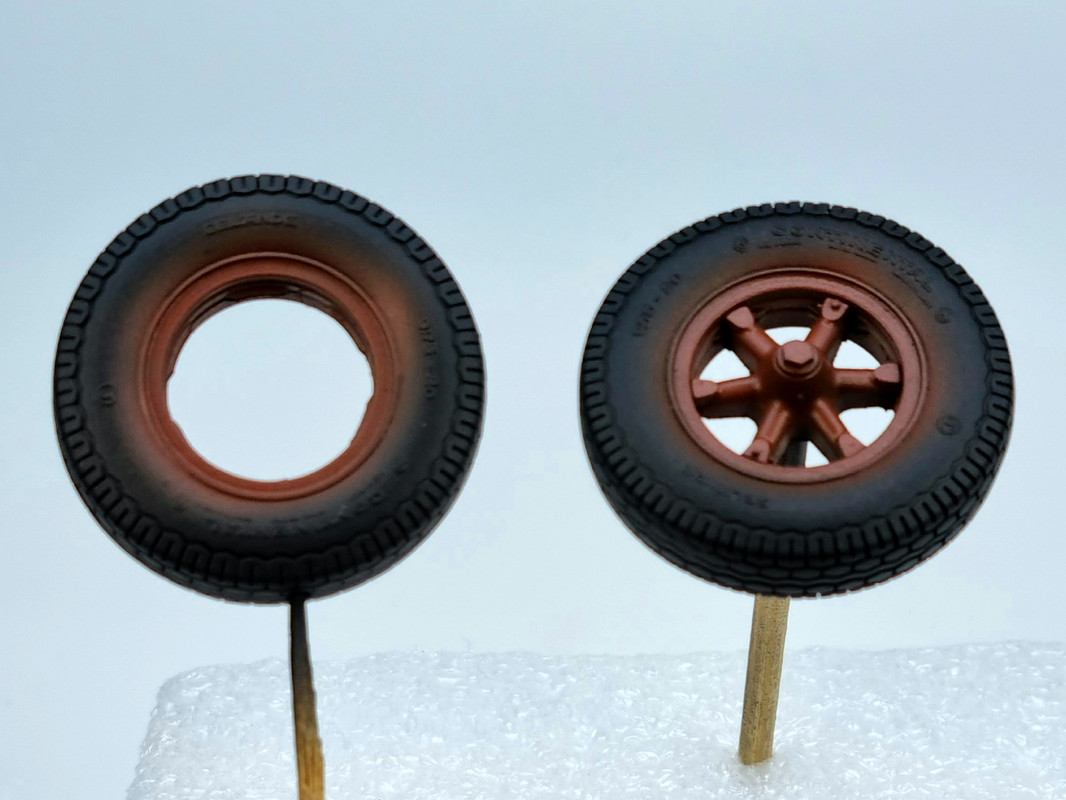 
Like many happy accidents I discovered this odd sequence of working by mistake! I had not used a wheel mask on some truck front wheels and allowed too much dark yellow paint onto an already painted tyre. As luck would happen, I had intended to chip the wheel-coloured base coat, so a hairspray layer had already been added over some red oxide primer. With that in mind I figured it would be easy to remove the overspray. Halfway through the process I discovered the effect of leaving remnants of paint acted like natural dirt/dust accumulation on the tyre. This effect only really works where the vehicle wheel colour is of similar shade to dust or dirt so a dark yellow in this case works perfectly. So, now on projects that display an operational vehicle, I can now produce these first layers of dirt build up during the painting stage.
 
As mentioned above, the wheel is primed, in this case with red oxide then the rubber paint colour is applied to the tyres, followed by a hairspray layer. The wheels are then painted and depending on how far out on the tyre you wish to display the effect, an intentional light overspray in a circular motion over the tyre is all that is required. Then, much like paint chipping on metalwork areas of the model the idea is to now 'scrub' away some of the paint on the tyre sections. How much you leave on the tyre is entirely up to you. I tend to drag a damp brush outward from the centre of the wheel as this will leave deposits of paint on the tyre just outside the rim but there is no right or wrong way of doing it. The intention is to leave a credible looking build-up of muck on the tyre to which further weathering effects can be added.
 
Colour consistency
Working in sub-assemblies can have it's drawbacks during the painting stages so it was now important to check and ensure they all worked in harmony. A quick test fit of the wheels and load bed to the chassis would highlight any stark colour variations in the paint application. Happy to proceed it was now time to protect all the paint work laid down so far. It would also prepare the surface for decals and future weathering.
Clear coat
A coat of VMS Satin Varnish was airbrushed over the cab and cargo bed portions. Parts that had rubber tyres received a coat of Vallejo matt varnish.
|
|
losboz
Full Member
  
Member since: September 2013
Posts: 322 
|
Post by losboz on Mar 23, 2023 9:44:22 GMT -5
Some great building Los and nice to see the comparisons as well  Cheers Boots and yes some quite stark differences in appearance and far more so when it comes to both detail and engineering |
|
|
|
Post by tcoat on Mar 23, 2023 12:48:32 GMT -5
|
|
|
|
Post by mustang1989 on Mar 24, 2023 7:32:18 GMT -5
Your step by step methods are VERY appreciated!!! I read all the way through the posts so as to get all of the useful information out of it and have to say that the results you get are just amazing. Thank you for sharing this with us. Looking forward to the next update.
|
|
|
|
Post by Steve Zuleski on Mar 24, 2023 10:48:06 GMT -5
Excellent progress, bookmarked!
|
|
|
|
Post by `Boots` on Mar 25, 2023 9:33:17 GMT -5
That is some sublime work Los and i use the slight over spray method as well, i never bother being to precise when painting wheels....especially armour/softskins etc.....don`t matter how many accidents you have it always seems to work out in the end  .......i`ve lost count of the number of times i`ve messed up during weathering and ended up liking it  |
|
losboz
Full Member
  
Member since: September 2013
Posts: 322 
|
Post by losboz on Mar 25, 2023 17:10:17 GMT -5
Your step by step methods are VERY appreciated!!! I read all the way through the posts so as to get all of the useful information out of it and have to say that the results you get are just amazing. Thank you for sharing this with us. Looking forward to the next update. Appreciated. Thanks bud |
|
losboz
Full Member
  
Member since: September 2013
Posts: 322 
|
Post by losboz on Mar 25, 2023 17:10:56 GMT -5
Excellent progress, bookmarked! Cheers Steve, glad to have you along😊 |
|
losboz
Full Member
  
Member since: September 2013
Posts: 322 
|
Post by losboz on Mar 25, 2023 17:13:09 GMT -5
That is some sublime work Los and i use the slight over spray method as well, i never bother being to precise when painting wheels....especially armour/softskins etc.....don`t matter how many accidents you have it always seems to work out in the end  .......i`ve lost count of the number of times i`ve messed up during weathering and ended up liking it  Cheers Boots. Sweet when things work out way better than you ever anticipated. |
|
losboz
Full Member
  
Member since: September 2013
Posts: 322 
|
Post by losboz on Mar 26, 2023 15:08:11 GMT -5
Choosing a subjectOver the last few years, I have really enjoyed re-creating period images of vehicles. With such a wealth of online material it is often possible to find multiple images which makes the task of replicating actual vehicles a real possibility. Before I added the licence plate decals I did a little research and picked out a vehicle that I would loosely replicate. Two images caught my eye from the fantastic Canfora publication ‘AFV Photo Album’ As per the caption this 8t was likely to have been from the 6th Pz.Div and together with the 3.7cm Flak it was towing, was abandoned in Polná, Czechoslovakia in 1945. With a little detective work and the aid of Google maps I managed to track down the location of the original photo. It was evident it sat on a slight incline and the buildings adjacent were still standing. I already had a Flak 3.7cm almost completely built I set about sourcing material to place them on a suitably sized base.
|
|
losboz
Full Member
  
Member since: September 2013
Posts: 322 
|
Post by losboz on Mar 26, 2023 15:37:01 GMT -5
Towing the flak 37My AA gun was taken from the recently released Tamiya/ICM Renault AHN truck combo kit. The Tamiya Flak and trailer mouldings are from the 1980's and there have been far more accurate kits released since then, but to keep the project momementum I would use what I already had built. As the Sd.Ah 52 trailer wheels had been removed in the image I used a set of 3D resin brake drums from a Sd.Ah56/57 trailer. To replicate the hub and wheel studs I sanded the rear of a pair of outer Sd.Kfz 251 wheels until just the central hub remained. These were then added to the 3D drums and fixed to the trailer axles. Looking at the image the trailer also had a few grab handles that were not present on the kit, so these were made up from copper wire. To give the scene a little contrast I plan to give the flak and trailer a faded winter whitewash over a field applied Autumn camo. First primed with Tamiya Fine Surface Primer the barrel and selected areas were then undercoated in Tamiya Nato black. This would serve not only as the initial colour for the weapon but also to replicate bare metal.  After two fine coats of hairspray, a red oxide primer coat was applied. This layer was then chipped exposing the bare metal colour underneath. 
After another application of hairspray, a base coat of Tamiya XF88 Dark Yellow 2 lightened with Deck Tan XF55 was airbrushed and again chipped back. This time exposing the red oxide and in places, down to the bare metal. As you can in the pic below there is very little overspray still visible on the gun. This is another massive benifit of using hairspray between coats as any overspray, if required can simply be 'chipped' away completely.  The next step was to add the Autumn camo pattern. MRP Red Brown was airbrushed over hairspray and when dry the camo colour was lightly chipped and worn down.  For the whitewash a mix of Tamiya white XF2 with a few drops of Buff XF57 was thinned with tap water. I find the absence of thinner not only makes the process of chipping easier, but leaves a softer transition between the two layers of paint and ideal in reprensenting a worn and faded whitewash. After a hairspray layer this coat was laid down lightly and in a random pattern spraying it a little thicker to areas that would have retained more whitewash over time. My intention was to leave only light traces of the whitewash.
With the whitewash now saturating the overall colour down, it was now time to up the contrast again with a filter of Grey Ochre. Once dry, Abtielung oils were used to enhance more details and add slight variations in colour. They were used damp in areas as you would with a pin wash but also drybrushed on dry to catch edges.Damaged areas of metalwork received some rust tones and minute amounts of pigments were added to oils on the Flak mount to create damp areas.
The Flak is ready awaiting some dry foilage and dust.
|
|
|
|
losboz
Full Member
  
Member since: September 2013
Posts: 322 
|
Post by losboz on Mar 27, 2023 5:29:57 GMT -5
|
|
|
|
Post by `Boots` on Mar 27, 2023 5:43:11 GMT -5
That is some fantastic research los and a fantasticly matching Flak as well......love the way you explain things in detail regarding the paint/weathering etc, i too enjoy browsing the web for build ideas but most of the things i like only have a flippin` side view  |
|
transammike
Junior Member
 
Member since: February 2023
Posts: 31
Feb 27, 2023 15:11:15 GMT -5
Feb 27, 2023 15:11:15 GMT -5
|
Post by transammike on Mar 27, 2023 12:13:27 GMT -5
WOW, thats some incredible work!!
|
|
Whiterook
Full Member
  
Member since: March 2013
Modeler & Wargamer
Posts: 905
Mar 13, 2013 15:29:19 GMT -5
Mar 13, 2013 15:29:19 GMT -5
|
Post by Whiterook on Mar 27, 2023 18:36:02 GMT -5
|
|
|
|
Post by chromdome35 on Mar 28, 2023 9:29:48 GMT -5
This is serious top-quality work, I'm totally impressed.
How long did this model take to complete?
Do you use hairspray or one of the chipping fluids?
|
|
losboz
Full Member
  
Member since: September 2013
Posts: 322 
|
Post by losboz on Mar 28, 2023 9:51:15 GMT -5
This is serious top-quality work, I'm totally impressed. How long did this model take to complete? Do you use hairspray or one of the chipping fluids? Cheers again As you can see, I like my 8T halftracks  I am currently working my way through quite a few of them. I’ve completed (recently posted on here) the Trumpeter Sd.Kfz.7 Flak 43, the Sd.Kfz.7 Holzpritsche and I am currently working on this. I have Dragon kit 6794 started and almost 100% built. Kit 6918 is yet to be opened and the ancient and venerable Tamiya kit 35148 is also a WIP. Updated with Modelkasten wheels and tracks, a huge fret of PE and some resin wheels it should make an interesting comparison with all the mid 2000 offerings. This kit is still a work in progress. As per the thread the kit was almost 100% fully built in 2015 and I reckon took maybe 28hrs to build (at my pace ) The paintwork started at the beginning of March this year and I've probably got another 25% to go including the little vignette they will sit on. I use both hairspray (Tresemme fine mist is my go-to) and chipping fluid. Straight out of the can for full cover and decanted or chipping fluid through the airbrush for individual areas. Hope that helps. Los |
|
|
|
Post by chromdome35 on Mar 28, 2023 10:31:04 GMT -5
I use both hairspray (Tresemme fine mist is my go-to) I have had a hard time finding Tresemme fine mist online in single cans. Where do you get it? |
|
losboz
Full Member
  
Member since: September 2013
Posts: 322 
|
Post by losboz on Mar 28, 2023 10:54:29 GMT -5
I have had a hard time finding Tresemme fine mist online in single cans. Where do you get it? I luckily have enough supply for another 6months or so, but I understand it is tricky to find the fine mist here in the UK now. I believe their spray products are numbered now so I wouldn’t have a clue what would be the equivalent type to fine mist. Amazon US were still selling it a few months ago. Sorry I cant be more help |
|
|
|
Post by chromdome35 on Mar 28, 2023 11:08:41 GMT -5
No worries!
I found it on Amazon but only in a 6 pack which I really don't want to buy that much of it.
|
|











































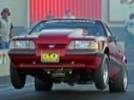





















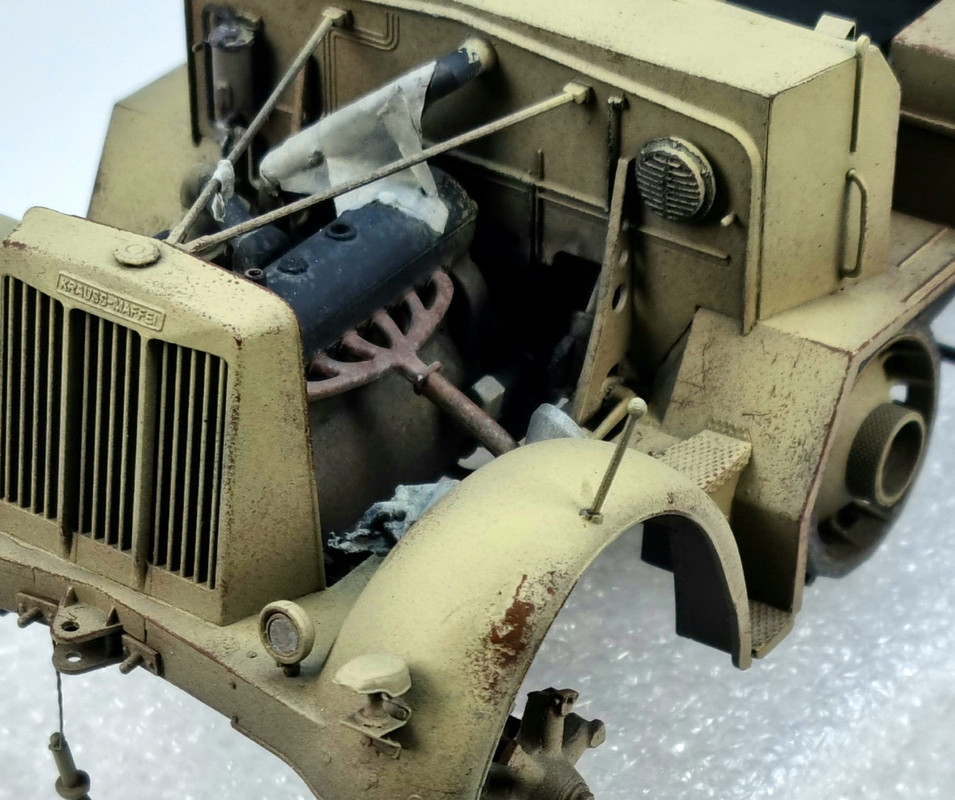














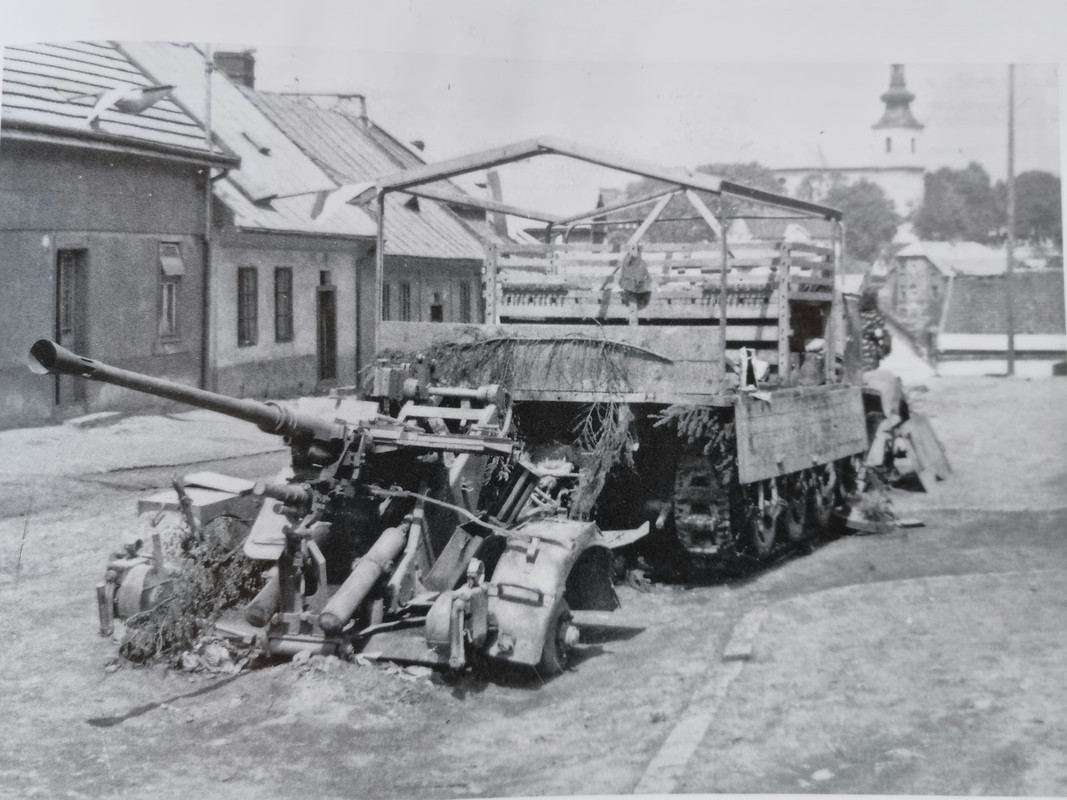

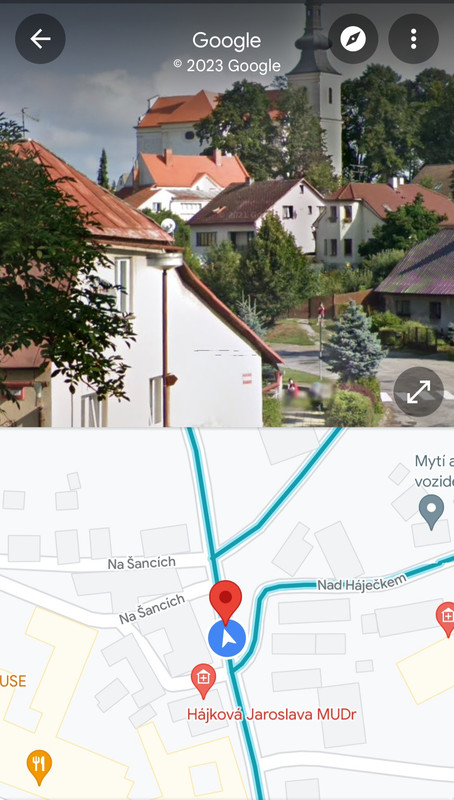

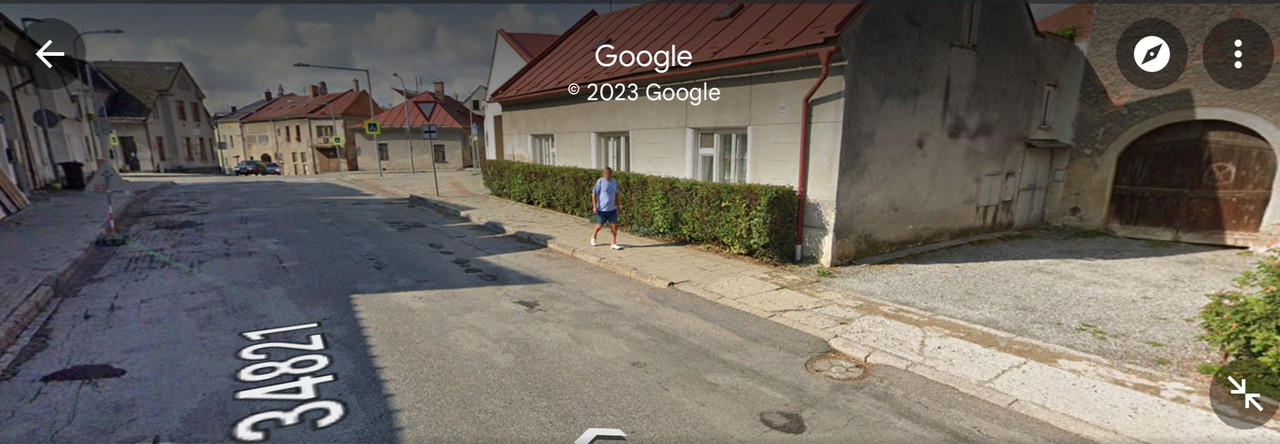














 I am currently working my way through quite a few of them. I’ve completed (recently posted on here) the Trumpeter Sd.Kfz.7 Flak 43, the Sd.Kfz.7 Holzpritsche and I am currently working on this. I have Dragon kit 6794 started and almost 100% built. Kit 6918 is yet to be opened and the ancient and venerable Tamiya kit 35148 is also a WIP. Updated with Modelkasten wheels and tracks, a huge fret of PE and some resin wheels it should make an interesting comparison with all the mid 2000 offerings.
I am currently working my way through quite a few of them. I’ve completed (recently posted on here) the Trumpeter Sd.Kfz.7 Flak 43, the Sd.Kfz.7 Holzpritsche and I am currently working on this. I have Dragon kit 6794 started and almost 100% built. Kit 6918 is yet to be opened and the ancient and venerable Tamiya kit 35148 is also a WIP. Updated with Modelkasten wheels and tracks, a huge fret of PE and some resin wheels it should make an interesting comparison with all the mid 2000 offerings.